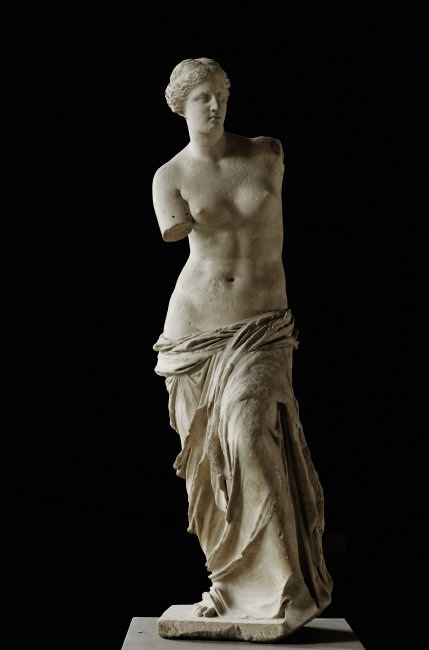Emma Myers and Bridget Gonzalez

Connection between Nike of Samothrace and Aphrodite of Melos:
Exemplifying the spread of Greek culture throughout the world, both of these sculptures show many conventions of Hellenistic art. One convention includes a harmonious connection between the intricate drapery and skin. The twists and deep undercuts of the drapery, "conform faithfully to the nude body underneath." (Robertson 553-4) During the Hellenistic period, art was changed from religious and naturalistic themes to dramatic human expression. Many Hellenistic pieces embrace the physical surroundings with dramatic groupings like the imaginary wind shaping and transforming the drapery and wings in the Nike of Samothrace. Bodies are powerful, voluptuous with ,"ideal portions, high waste, sharp twists of the legs, and a seductive Praxiteles “S” curve in the torso". (Robertson 554) The postures depict inner feelings, thoughts, and attitudes. The pieces include, "dramatic posing, sweeping lines, and high contrast in light, shadows, and emotions." (Furtwängler 400)
[Nike of Samothrace, marble, h. 2.4 m, 3rd century bc;(Paris, Musée du Louvre); photo credit: Réunion des Musées Nationaux/Art Resource, NY.Accessed through Grove Art Online.]

Nike of Samothrace:
From the Sanctuary of the Great Gods in Samothrace, a city on the coast of now modern Turkey, the Nike (Victory) of Samothrace displays a strikingly strong woman with eagle-like wings. Used to memorialize achievements, the 8 foot headless and armless marble figure personifies the belief of a woman that soars through the air, landing on a boat to which she will award a leafy crown of victory to a chosen mortal. With rocks and pools of water lying at the bottom of her dress, the sculpture is, "a constant reminder of the perils of any battle fought off Greek coasts." (Furtwängler 375)
Aphrodite of Melos
The semi-nude 6’10” marble sculpture, Aphrodite of Melos, represents a woman with a "dreamy head and gaze".(Robertson 553) In a, "twisted stance with a strong projection of her left knee", this structure was believed to be a victorious Venus. (Haskell 329) During the hastiness of the assembly, not all of the pieces were found, including the arms which would have been holding an apple of Paris. When the statue was found, c 150 BCE, an inscribed block was found with a signature of its Hellenistic sculptor Alexandros of Antioch on the Meander.In order to attribute it to the famed classical Greek artist Praxiteles, the statue was dissociated from the inscribed block. Though moved around many times, the statue was never restored. The original Praxiteles statue was found on the Aegean island of Melos by French excavators.
[Alexandros of Antioch on the Maeander: Venus de Milo, marble, h. 2.04 m, Hellenistic period, c. 150–c. 120 BC (Paris, Musée du Louvre); Photo credit: Erich Lessing/Art Resource, NY Accessed through Grove Art Online.]
Bibliography:
Boardman, John. Greek Art. New York, New York: Thames and Hudson, 1996.
Haskell, Francis and Penny, Nicholas. The Lure of Classical Sculpture Taste and the Antique. New Haven, Conneticuit: Yale UP, 1981. pp. 328–30.
Loggia. “Hellenistic Art.” Loggia: Exploring the Arts and Humanities! 4 Dec. 2008. Loggia. 4 Dec. 2008 <http://www.loggia.com/art/ancient/hellenistic.html>.
Robertson, Martin. A History of Greek Art. Cambridge: Cambridge UP, 1975. pp. 553–4.
Onians, John. Classical Art and the Cultures of Greece and Rome. New Haven, Conneticuit: Yale UP, 1999.
Stokstad, Marilyn. Art: A Brief History. Upper Saddle River, New Jersey: Pearson Prentice Hall, 2007.
Furtwängler, W. Masterpieces of Greek Sculpture. London: 1895. pp. 367–401
Comments (0)
You don't have permission to comment on this page.